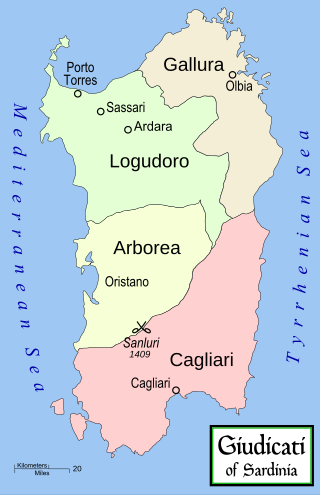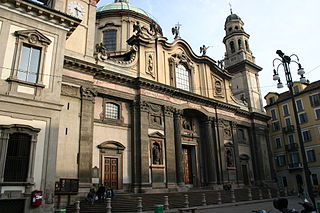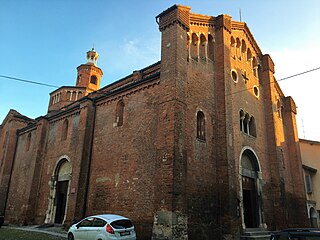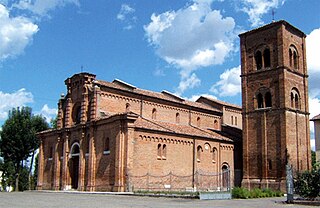
The Patriarchal Cathedral Basilica of Saint Mark, commonly known as St Mark's Basilica, is the cathedral church of the Patriarchate of Venice; it became the episcopal seat of the Patriarch of Venice in 1807, replacing the earlier cathedral of San Pietro di Castello. It is dedicated to and holds the relics of Saint Mark the Evangelist, the patron saint of the city.

The Judicates, in English also referred to as Sardinian Kingdoms, Sardinian Judgedoms or Judicatures, were independent states that took power in Sardinia in the Middle Ages, between the ninth and fifteenth centuries. They were sovereign states with summa potestas, each with a ruler called judge, with the powers of a king.
Gianni Baget Bozzo was an Italian Catholic priest and politician.

Sant'Alessandro in Zebedia is a parish church in Milan, Italy. It is a distinctive example of the early Lombard Baroque.

Santa Maria del Carmine is a church in Pavia, Lombardy, northern Italy, considered amongst the best examples of Lombard Gothic architecture. It was begun in 1374 by Gian Galeazzo Visconti, Duke of Milan, on a project attributed to Bernardo da Venezia. The construction followed a slow pace, and was restarted in 1432, being finished in 1461.

San Nicola di Trullas is a countryside church between the communes of Semestene and Pozzomaggiore, in the province of Sassari, Sardinia, Italy

San Giusto is a church in Lucca, Tuscany, central Italy. Built over a pre-existing church, it dates to the second half of the 12th century. Its titular is the 12th century Italian, Giustino Salce, whence the name "San Giusto".

Sant’Alessandro Maggiore is a Romanesque-style, Roman Catholic parish church in Lucca, region of Tuscany, Italy.

The Tempietto di Santa Croce is a small octagonal Romanesque chapel found in the upper city of Bergamo, near the Santa Maria Maggiore. The original building was constructed in the first half of the 11th century, though first documentation of the structure dates to 1133. Other Romanesque structures in the province include the Rotonda di San Tomè, the Basilica di Santa Giulia, and the Priorato di Sant'Egidio.

Santa Maria is a medieval church in the comune of Uta, Sardinia, Italy.

San Teodoro is a Romanesque-style Roman Catholic church in the town center of Pavia, Italy.
Mario Salmi was an Italian art historian and art critic who specialized in Romanesque architecture, Tuscan sculpture and the early Italian Renaissance.

The Marquisate of Oristano was a marquisate of Sardinia that lasted from 1410 until 1478

The Sardinian Romanesque is the Romanesque architectural style that developed in Sardinia. The Romanesque architecture in Sardinia has had a remarkable development since the early origins, during the Giudicati era, and for a long period. His expressions, although autonomous, are not classifiable in a recognizable image, since in the island the Romanesque manifested itself with unusual results but in numerous forms; this is due to the establishment in Sardinia of several religious orders, coming from various Italian regions and from France. Consequently, in the architectures of that era Pisan, Lombard and Provençal influences are recognizable as well as traces of the passage of workers, coming from the Iberian Peninsula, of Islamic culture.

San Lanfranco is a Romanesque-style Catholic church and former abbey, located on via San Lanfranco Vescovo, 4/6, just west of the town center of Pavia, region of Lombardy, Italy.

The pieve of Our Lady of the Snows is a Romanesque church located in Quarantoli, village near Mirandola, in the province of Modena and Roman Catholic Diocese of Carpi.

The church of Santa Maria in Betlem, founded around 1130, stands in the characteristic district of the Borgo of Pavia, located, after the Ponte Coperto, on the other bank of the Ticino river from the city center.

The monastery of San Felice was one of the main female Benedictine monasteries of Pavia; founded since the Lombard period, it was suppressed in the 18th century.Part of the church and the crypt survive from the original Lombard complex.

The Church of San Lazzaro is located on the eastern suburbs of Pavia. Built in the 12th century along the Via Francigena, it was equipped with a hospital dedicated to the care of pilgrims and lepers.

















